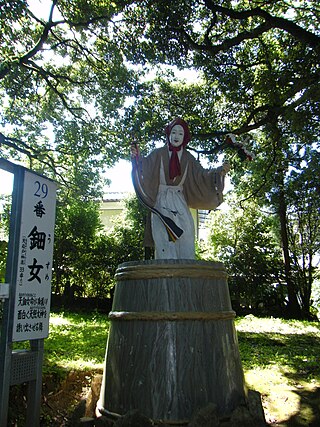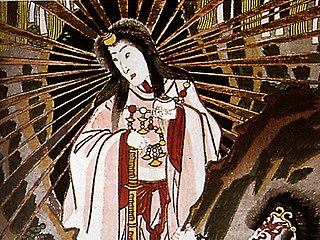Related Research Articles

The Wild Hunt is a folklore motif occurring across various northern European cultures. Wild Hunts typically involve a chase led by a mythological figure escorted by a ghostly or supernatural group of hunters engaged in pursuit. The leader of the hunt is often a named figure associated with Odin in Germanic legends, but may variously be a historical or legendary figure like Theodoric the Great, the Danish king Valdemar Atterdag, the dragon slayer Sigurd, the Welsh psychopomp Gwyn ap Nudd, biblical figures such as Herod, Cain, Gabriel, or the Devil, or an unidentified lost soul either male or female. The hunters are generally the souls of the dead or ghostly dogs, sometimes fairies, valkyries, or elves.
Aradia is one of the principal figures in the American folklorist Charles Godfrey Leland's 1899 work Aradia, or the Gospel of the Witches, which he believed to be a genuine religious text used by a group of pagan witches in Tuscany, a claim that has subsequently been disputed by other folklorists and historians. In Leland's Gospel, Aradia is portrayed as a messiah who was sent to Earth in order to teach the oppressed peasants how to perform witchcraft to use against the Roman Catholic Church and the upper classes.

In Gaelic myth, the Cailleach is a divine hag and ancestor, associated with the creation of the landscape and with the weather, especially storms and winter. The word literally means 'old woman, hag', and is found with this meaning in modern Irish and Scottish Gaelic, and has been applied to numerous mythological and folkloric figures in Ireland, Scotland, and the Isle of Man. In modern Irish folklore studies, she is sometimes known as The Hag of Beara, while in Scotland she is known as Beira, Queen of Winter.

Ēostre is a West Germanic spring goddess. The name is reflected in Old English: *Ēastre, Old High German: *Ôstara, and Old Saxon: *Āsteron. By way of the Germanic month bearing her name, she is the namesake of the festival of Easter in some languages. The Old English deity Ēostre is attested solely by Bede in his 8th-century work The Reckoning of Time, where Bede states that during Ēosturmōnaþ, pagan Anglo-Saxons had held feasts in Ēostre's honour, but that this tradition had died out by his time, replaced by the Christian Paschal month, a celebration of the resurrection of Jesus.

The bogeyman is a mythical creature used by adults to frighten children into good behaviour. Bogeymen have no specific appearances and conceptions vary drastically by household and culture, but they are most commonly depicted as masculine or androgynous monsters that punish children for misbehaviour. The bogeyman, and conceptually similar monsters can be found in many cultures around the world. Bogeymen may target a specific act or general misbehaviour, depending on the purpose of invoking the figure, often on the basis of a warning from an authority figure to a child. The term is sometimes used as a non-specific personification of, or metonym for, terror, and sometimes the Devil.

Ame-no-Uzume-no-Mikoto is the goddess of dawn, mirth, meditation, revelry and the arts in the Shinto religion of Japan, and the wife of fellow-god Sarutahiko Ōkami. She famously helped draw out the missing sun deity, Amaterasu Omikami, when she had hidden herself in a cave. Her name can also be pronounced as Ama-no-Uzume-no-Mikoto. She is also known as Ōmiyanome-no-Ōkami, an inari kami possibly due to her relationship with her husband. She is also known as Ame-no-Uzume-no-Mikoto, The Great Persuader, and The Heavenly Alarming Female. She is depicted in kyōgen farce as Okame, a woman who revels in her sensuality.

English folklore consists of the myths and legends of England, including the English region's mythical creatures, traditional recipes, urban legends, proverbs, superstitions, and folktales. Its cultural history is rooted in Celtic, Christian, Nordic and Germanic folklore.

Japanese mythology is a collection of traditional stories, folktales, and beliefs that emerged in the islands of the Japanese archipelago. Shinto traditions are the cornerstones of Japanese mythology. The history of thousands of years of contact with Chinese and various Indian myths are also key influences in Japanese religious belief.
The Triple Goddess is a deity or deity archetype revered in many Neopagan religious and spiritual traditions. In common Neopagan usage, the Triple Goddess is viewed as a triunity of three distinct aspects or figures united in one being. These three figures are often described as the Maiden, the Mother, and the Crone, each of which symbolizes both a separate stage in the female life cycle and a phase of the Moon, and often rules one of the realms of heavens, earth, and underworld. In various forms of Wicca, her masculine consort is the Horned God.

In folklore, a crone is an old woman who may be characterized as disagreeable, malicious, or sinister in manner, often with magical or supernatural associations that can make her either helpful or obstructive. The Crone is also an archetypal figure or a Wise Woman. As a character type, the crone shares characteristics with the hag. The word became further specialized as the third aspect of the Triple Goddess popularized by Robert Graves and subsequently in some forms of neopaganism. In Wicca, the crone symbolizes the Dark Goddess, the dark side of the moon, the end of a cycle; together with the Mother Crone, the Light Goddess and the Crone Maiden, Day Goddess, she represents part of the circle of life. The Handsome Warlock or Beautiful Witch, good or bad may change a Crone or Hag to normal looks, appearance if so desired.

Hilda Roderick Ellis Davidson was an English folklorist. She was a scholar at the University of Cambridge and The Folklore Society, and specialized in the study of Celtic and Germanic religion and folklore.
The cù-sìth(e), plural coin-shìth(e) is a mythical hound found in Irish folklore and Scottish folklore. In Irish folklore it is spelled cú sídhe, and it also bears some resemblance to the Welsh Cŵn Annwn.

Kurdish mythology is the collective term for the beliefs and practices of the culturally, ethnically or linguistically related group of ancient peoples who inhabited the Kurdistan mountains of northwestern Zagros, northern Mesopotamia and southeastern Anatolia. This includes their Indo-European pagan religion prior to them converting to Islam, as well the local myths, legends and folklore that they produced after becoming Muslims.
Jenny Greenteeth a.k.a. Wicked Jenny, Ginny Greenteeth and Grinteeth is a figure in English folklore. A river-hag, similar to Peg Powler and derived from the grindylow, she would pull children or the elderly into the water and drown them. The name is also used to describe pondweed or duckweed, which can form a continuous mat over the surface of a small body of water, making it misleading and potentially treacherous, especially to unwary children. With this meaning the name is common around Liverpool and southwest Lancashire.
Dane Hills is a large area on the western side of the English city of Leicester. It consists of the smaller areas of Newfoundpool, Western Park, and New Parks, which is bounded by Glenfield to the west. A cave in this area was known as Black Annis's Bower; the cave was reputed to be the lair of a witch or hag of that name.
Micronesian mythology comprises the traditional belief systems of the people of Micronesia. There is no single belief system in the islands of Micronesia, as each island region has its own mythological beings.
Lotte Motz, born Lotte Edlis, was an Austrian-American scholar, obtaining a Ph.D. in German and philology, who published four books and many scholarly papers, primarily in the fields of Germanic mythology and folklore.

A hag is a wizened old woman, or a kind of fairy or goddess having the appearance of such a woman, often found in folklore and children's tales such as "Hansel and Gretel". Hags are often seen as malevolent, but may also be one of the chosen forms of shapeshifting deities, such as The Morrígan or Badb, who are seen as neither wholly benevolent nor malevolent.

In folklore and literature, the Fairy Queen or Queen of the Fairies is a female ruler of the fairies, sometimes but not always paired with a king. Depending on the work, she may be named or unnamed; Titania and Mab are two frequently used names. Numerous characters, goddesses or folkloric spirits worldwide have been labeled as Fairy Queens.
References
- 1 2 3 4 5 6 7 Briggs, Katharine (1976). Encyclopedia of Fairies. Pantheon Books. pp. 24–25. ISBN 978-0-394-73467-5.
- 1 2 3 4 Alexander, Marc (2002). A Companion to the Folklore, Myths & Customs of Britain. BCA. p. 23.
- ↑ Billson, Charles James (1895). "Leicestershire and Rutland" in County Folk-Lore (Vol. 1). The Folklore Society. pp. 4–9.
- ↑ Billson (1895). p. 8.
- 1 2 3 4 Mackenzie, Donald A. (1917). Myths of Crete and Pre-Hellenic Europe. Kessinger. pp. 111–122.
- ↑ Billson (1895). pp. 8–9.
- ↑ Black Annis – leicester legend or Widespread Myths
- 1 2 Turner, Patricia & Coulter, Charles Russell (2001). Dictionary of Ancient Deities. Oxford University Press. p. 102. ISBN 978-0-19-514504-5.
- ↑ Spence, Lewis (1972). The Minor Traditions of British Mythology. Ayer. p. 29. ISBN 978-0-405-08989-3.
- 1 2 3 Hutton, Ronald (2001). The Triumph of the Moon: A History of Modern Pagan Witchcraft. Oxford University Press. pp. 274–275. ISBN 978-0-19-285449-0.
- ↑ BBC – h2g2 – Black Annis – Legend of Leicester
- ↑ Billson (1895). p. 6.
- ↑ Billson (1895). pp. 4–6.
- ↑ Billson (1895). pp. 76–77.
- 1 2 Billson (1895). p. 9.